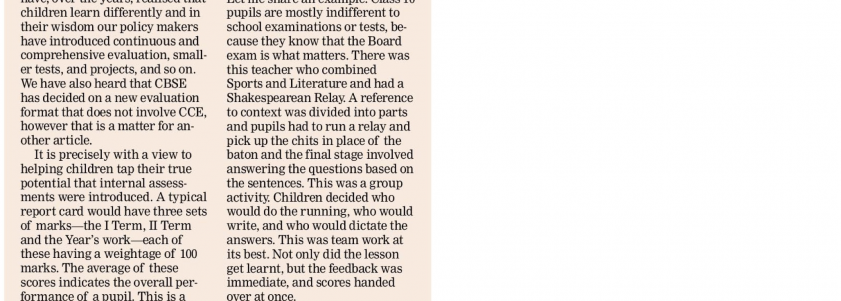Tests and examinations will continue to be held, but we as teachers can make the process of setting ‘those test papers’ and evaluating ‘those tests’ more interesting.
Children go to school ostensibly to learn or be educated, and this needs to be ‘measured’ so that some kind of feedback about the pupil is given to the parents and the management (with a view to gauge the teachers’ performance). Evaluating a pupil’s learning should ideally be done through the four skills—listening, reading, writing and speaking. But, by and large, our recap mechanism is largely restricted to writing, and that is done through tests and examinations. However, all of us know that this method tests mostly recall and, if the teacher is creative, some amount of application. We are also aware that not all children can memorise large quantities of matter, and again, not all of them are good at writing. We have, over the years, realised that children learn differently and in their wisdom our policy makers have introduced continuous and comprehensive evaluation, smaller tests, and projects, and so on. We have also heard that CBSE has decided on a new evaluation format that does not involve CCE, however that is a matter for another article.
It is precisely with a view to helping children tap their true potential that internal assessments were introduced. A typical report card would have three sets of marks—the I Term, II Term and the Year’s work—each of these having a weightage of 100 marks. The average of these scores indicates the overall performance of a pupil. This is a broad pattern with slight variations depending on the school. However, all schools do have internal assessments which test the above mentioned four skills over and above their regular examinations.
Listening: This can be tested in a variety of ways—aural comprehensions, dodging tables, quiz, and so on. These help the teacher know how alert the child is in the class, and the feedback is immediate too.
Speaking: This can be done through recitation, oral questioning, picture talk, and other such activities. Here too, the teacher is able to gauge a host of other parameters—confidence, pronunciation, clarity, and so on.
Reading: This is not only very simple, but breaks the monotony of just the teacher’s voice being heard. Pupils love reading because it gives them a sense of participation. The parameters being evaluated too are several others besides recall.
Writing: So what is new about this? It depends on the teacher. Instead of the usual paper-pencil tests, the teacher can have a host of activities—word search, crosswords, drawing the missing parts, give the answer through diagrams, role play, painting a poem, and so on.
When a teacher is creative, believe me, children wait for the test period. Having been in a school for a quarter of a century I have had the opportunity to interact with some brilliant teachers. Let me share an example. Class 10 pupils are mostly indifferent to school examinations or tests, because they know that the Board exam is what matters. There was this teacher who combined Sports and Literature and had a Shakespearean Relay. A reference to context was divided into parts and pupils had to run a relay and pick up the chits in place of the baton and the final stage involved answering the questions based on the sentences. This was a group activity. Children decided who would do the running, who would write, and who would dictate the answers. This was team work at its best. Not only did the lesson get learnt, but the feedback was immediate, and scores handed over at once.
Internal assessments can be in the form of a PowerPoint Presentation, a film, interviews that are recorded, mathematical games, chemical reactions that can be disguised as puzzles, songs, poems written by pupils, stories or novellas written as a group, a travel brochure (giving all details of the place being dealt with), a class/school newspaper, to mention a few. Yes, there will be sceptics who will say that the evaluation may not be 100 per cent correct, and the work involved is too much and so on. But, we need to try. Yes, it may not turn out right the first time, but you cannot give up without trying. There are, to my knowledge, several teachers who are breaking new grounds and daring to be different vis-à-vis evaluation but these are few and far between.
Tests and examinations will continue to be held, but we as teachers can make the process of setting ‘those test papers’ and evaluating ‘those tests’ more interesting. How to do it depends on the teachers… and of course the freedom given to them by the management.
Author: Dr. Ranjini Krishnaswamy
Email: jinikay@gmail.com
This Article was published in the DNA Newspaper (Mumbai Edition) on 3rd April 2017. You can read it here.





